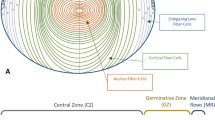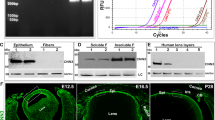Abstract
During newt lens regeneration, the pigmented epithelial cells (PECs) of the dorsal iris dedifferentiate and give rise to a new lens. We have studied the cytoskeleton of the PECs using iris flat mounts and sections. In flat-mount iris preparations stained by labelled phalloidin three main regions can be recognized: the pupillary (P) ring, the middle (M) ring, and the more external junctional (J) ring. The cells of the P ring that give rise to the lens have an elongated spindle shape and exhibit an elaborate cytoskeleton of actin filament bundles oriented along the long axis of the cell, reminiscent of myoepithelial or smooth muscle cells. These cells express smooth muscle-specific alpha actin, muscle gamma actin and cytokeratin II, and adhere to each other through the cell adhesion molecule A-CAM. During dedifferentiation, actin staining increases considerably as the actin filament bundles thicken and shorten and then accumulate preferentially in the apical and basal regions of the elongating lens fibres. Cytokeratin II, which is also organized as fibrils along the long axis of the normal iris PECs, increases progressively during dedifferentiation, when it is organized as a thick band surrounding the nucleus. The expression of this protein is repressed durign lens fibre differentiation, but is retained in mitotic cells. The data suggest that during cell type conversion some cytoskeletal proteins increase and reorganize, while others disappear during lens fibre differentiation.
Similar content being viewed by others
References
Alder H, Schmid V (1987) Cell cycles and in vitro transdifferentiation and regeneration of isolated, striated muscle of jellyfish. Dev Biol 124:358–369
Amsterdam A, Rotmensch S, Ben-Ze'ev A (1989) Coordinated regulation of morphological and biochemical differentiation in steroidogenic cell: the granulosa cell model. Trends Biochem Sci 14:377–382
Asch BB, Burstein NA, Vidrich A, Sun T (1981) Identification of mouse mammary epithelial cells by immunofluorescence with rabbit and guinea pig anti-keratin antisera. Proc Natl Acad Sci USA 78:5643–5647
Batsakis J.G., Kraemer B, Sciubba J (1983) The pathology of head and neck tumors: the myoepithelial cell and its participation in salivary gland neoplasia. 17. Head Neck Surg 5:222–233
Chapman DM, Pantin CFA, Robson EA (1962) Muscle in Coelenterates. Rev Can Biol 21:267–278
Cooper JA (1987) Effects of cytochalasin and phalloidin on actin. J Cell Biol 105:1473–1478
Cowley BD Jr, Chadwick LJ, Grantham JJ, Calvet JP (1989) Sequential protooncogene expression regenerating kidney following acute renal injury. J Biol Chem 264:8389–8393
Dairkee SH, Blayney C, Smith HS, Hackett AJ (1985) Monoclonal antibody that defines human myoepithelium. Proc Natl Acad Sci USA 82:7409–7413
Davson H (1990) The pupil. In: Davson H (ed) Physiology of the eye, 5th edn. Pergamon Press, New York, pp 754–766
Dumont JN, Yamada T (1972) Dedifferentiation of iris epithelial cells. Dev Biol 29:385–401
Eguchi G (1988) Cellular and molecular background of Wolffian lens regeneration. In: Eguchi G, Okada TS, Saxen L (eds) Regulatory mechanisms in developmental processes. Elsevier, Ireland, pp 147–158
Elgert K, Zalik SE (1989) Fibronectin distribution during cell-type conversion in newt lens regeneration. Anat Embryol 180:131–142
Estes JE, Selden LA, Gershman LC (1981) Mechanism of action of phalloidin on the polymerization of muscle actin. Biochemistry 20:708–712
Ferretti A, Brockes JP, Brown R (1991) A newt type keratin restricted to normal and regenerating limbs and tails is responsive to retinoic acid. Development 111:497–507
Franke WW, Schmid E, Freudenstein C, Appelhans B, Osborn M, Weber K, Keenan TW (1980) Intermediate-sized filaments of the prekeratin type in myoepithelial cells. J Cell Biol 84:633–654
Geiger B (1989) Cytoskeleton-associated cell contacts. Curr Opin Cell Biol 1:103–109
Gotlieb A (1990) The endothelial cytoskeleton: organization in normal and regenerating endothelium. Toxicol Pathol 18:603–617
Green KJ, Geiger B, Jones JCR, Talian JC (1987) The relationship between intermediate filaments and microfilaments before and during the formation of desmosomes and adherens-type junctions in mouse epidermal keratinocytes. J Cell Biol 104:1389–1402
Gugliotta P, Sapino A, Macri L, Skalli O, Gabbiani G, Bussolati G (1988) Specific demonstration of myoepithelial cells by antialpha smooth muscle actin antibody. J Histochem Cytochem 36:659–663
Hamperl H (1970) The myothelia (myoepithelial cells): normal state, regressive changes, hyperplasia, tumors. Curr Top Pathol 53:161–220
Herman OM (1993) Actin Isoforms. Curr Opin Cell Biol 5:48–65
Hori K, Hashimoto K, Eto H, Dekio S (1985) Keratin type intermediate filaments in sweat gland myoepithelial cells. J Invest Dermatol 85:453–459
Hornsby S, Zalik SE (1977) Redifferentiation, cellular elongation and cell surface during lens regeneration. J Embryol Exp Morphol 39:23–43
Klymkowsky MW, Maynell LA, Poison AG (1987) Polar symmetry in the organization of the cortical cytokeratin system of Xenopus laevis oocytes and embryos. Development 100:543–557
Koo EH, Hoffman PN, Price DL (1988) Levels of neurotransmitter and cytoskeletal protein mRNAs during nerve regeneration in sympathetic ganglia. Brain Res 449:361–363
Kulyk WM, Zalik SE (1982) Synthesis of sulfated glycosaminoglycans in the newt iris during lens regeneration. Differentiation 23:29–35
Kulyk WM, Zalik SE, Dimitrov E (1987) Hyaluronic acid production and hyaluronidase activity in the newt iris during lens regeneration. Exp Cell Res 172:180–191
Lazarides E, Woods C (1989) Biogenesis of the red blood cell membrane-skeleton and the control of erythroid morphogenesis. Annu Rev Cell Biol 5:427–452
LeBien TW, McCormack RT (1989) The common acute lymphoblastic leukemia antigen (CD10)-emancipation from a functional enigma. Blood 73:625–635
Mitchell D, Ibrahim S, Gusterson BA (1985) Improved immunohistochemical localization of tissue antigens using modified methacarn fixation. J Histochem Cytochem 33:491–495
Mizobuchi T, Yagi Y, Mizuno A (1990) Changes in α-tubulin and actin gene expression during optic nerve regeneration in frog retina. J Neurochem 55:54–59
Nagata K, Ichikawa Y (1984) Changes in actin during cell differentiation. In: Shay JW (ed) Cell and muscle motility, vol. 5. The cytoskeleton. Plenum Press, New York
Osborn M, Weber K (1982) Immunofluorescence and immunocytochemical procedures with affinity purified antibodies: tubulincontaining structures. In: Wilson L (ed) Methods in cell biology, vol 24. Academic Press, San Diego, pp 97–132
Reyer RW (1977) The amphibian eye: development and regeneration. In: Crescitelli F (ed) Handbook of sensory physiology, vol VII/5. Springer, Berlin Heidelberg New York, pp 309–390
Rodriguez MM, Hackett J, Donohoo P (1982) Iris. In: Jakobiec FA (ed) Ocular anatomy embryology and teratology. Harper & Row, Philadelphia, pp 285–302
Schmid V, Alder H (1984) Isolated, mononucleated, striated muscle can undergo pluripotent transdifferentiation and form a complex regenerate. Cell 38:801–809
Schmid V, Wydler M, Alder H (1982) Transdifferentiation and regeneration in vitro. Dev Biol 92:476–488
Shires AK, Rubenstein PA (1989) Nonuniform behavior of multiple isoactins in the same cell is a cell-dependent phenomenon. Cell Motil Cytoskeleton 14:236–270
Skalli O, Ropraz P, Trzeciak A, Benzonana G, Gillessen D, Gabbiani G (1986) A monoclonal antibody against α-smooth muscle actin: a new probe for smooth muscle differentiation. J Cell Biol 103:2787–2796
Snell RS, Lemp MA (1989) Development of the eye and the ocular appendages. In: Clinical anatomy of the eye. Blackwell, Oxford, pp1–18
Sobczak J, Tournier MF, Lotti AM, Duguet M (1989) Gene expression in regenerating liver in relation to cell proliferation and stress. Eur J Biochem 180:49–53
Stone LS (1967) An investigation recording all salamanders which can and can not regenerate a lens from the dorsal iris. J Exp Zool 164:87–104
Tashiro T, Komiya Y (1991) Changes in organization and axonal transport of cytoskeletal proteins during regeneration. J Neurochem 56:1559–1563
Torpey N, Wylie CC, Heasman J (1992) Function of maternal cytokeratin in Xenopus development. Nature 357:413–415
Tsukada T, Tippens D, Gordon D, Ross R, Gown AM (1987a) HHF-35, a muscle actin-specific monoclonal antibody. I. Immunocytochemical and biochemical characterization. Am J Pathol 127:51–60
Tsukada T, McNutt MA, Ross R, Gown AN (1987b). HHF-35, a muscle actin-specific monoclonal antibody. II. Reactivity in normal, reactive, and neoplastic human tissues. Am J Pathol 127:389–402
Vandekerckhove J, Weber K (1978a) Actin aminoacid sequences. Eur J Biochem 90:451–462
Vandekerckhove J, Weber K (1978b) At least six different actins are expressed in higher mammals: an analysis based on the amino acid sequence of the amino-terminal tryptic peptide. J Mol Biol 126:783–802
Vandekerckhove J, Weber K (1979) The complete amino acid sequence of actins from bovine aorta, bovine heart, bovine fast skeletal muscle and rabbit slow skeletal muscle. Differentiation 14:123–133
Wessels NK, Spooner BS, Ash JF, Bradley MO, Luduena MA, Taylor EL, Wrenn JT, Yamada KM (1971) Microfilaments in cellular and developmental processes. Science 171:135–143
Wieland T (1977) Modification of actins by phallotoxins. Naturwissenschaften 64:303–309
Wieland T, Faulstich H (1978) Amatoxins, phallotoxins, phallolysin, and antamanide: the biological active components of poisonous Amanita mushrooms. CRC Crit Rev Biochem 5:185–260
Yamada T (1967) Cellular and subcellular events in Wolffian lens regeneration. In: Moscona AA, Monroy A (eds) Current topics in developmental biology, vol 2. Academic Press, New York, pp 247–283
Yamada T (1977) Control mechanisms in cell-type conversion in newt lens regeneration. In: Wolsky A (ed) Monographs in developmental biology, vol 13. Karger, New York, pp 1–126
Yang YQ (1992) The cytoskeleton and a cell adhesion molecule during newt lens regeneration. MSc thesis, University of Alberta
Zalik SE, Scott V (1972) Cell surface changes during dedifferentiation in the metaplastic transformation of iris into lens. J Cell Biol 55:134–146
Zalik SE, Scott V (1973) Sequential disappearance of cell surface components during dedifferentiation in lens regeneration. Nature (New Biology) 244:212–214
Author information
Authors and Affiliations
Rights and permissions
About this article
Cite this article
Yang, Y., Zalik, S.E. The cells of the dorsal iris involved in lens regeneration are myoepithelial cells whose cytoskeleton changes during cell type conversion. Anat Embryol 189, 475–487 (1994). https://doi.org/10.1007/BF00186822
Accepted:
Issue Date:
DOI: https://doi.org/10.1007/BF00186822




